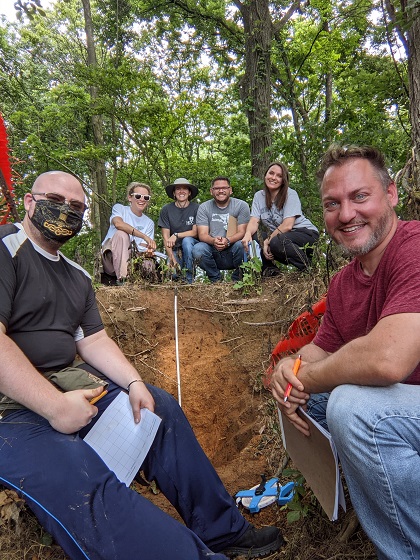Graduate Program Focus | Methods in Soil Ecology

"One of the things I love about soil science is that it is applicable on many scales. All of my students are now equipped to improve the health and fertility of the soil in their surroundings, whether that be through their work, research projects, internship experiences, or just in their own backyards."
Graduate Program Focus | Methods in Soil Ecology
Program
- Environmental Biology (M.S.)
- Geographic Information Systems (Certificate)
Department
- Biology
The Methods in Soil Ecology course is one of the many experiential learning opportunities Environmental Biology students at Hood College have access to. The class, taught by program director Dr. Kristin Fisher, teaches students how to sample soils for fertility analysis, interpret soil test results, describe field soil profiles and assess sites for land use suitability.
We spoke with Dr. Fisher to learn about the course and the benefits it can provide Environmental Biology students looking for hands-on learning opportunities.
Why did you and your Methods in Soil Ecology class decide to visit the Hood College garden to practice taking soil samples?
The one-credit “methods” courses in the Environmental Biology program strive to provide students with hands-on experiences in field and laboratory methods.
When it comes to sampling soils, it’s one thing to go over how to do it in the classroom. Taking it to the field forces students to think critically about environmental variability and the unanticipated problems you encounter when trying to sample in a way that will provide you with meaningful results.
The Hood College garden was a perfect setting for this because there are differences in management history, types of plants being grown and soil conditions necessary for ideal production. Students had to think through these existing conditions and decide how best to sample the soils to be able to generate meaningful and useful results for the garden managers.
You and your class learned that the Hood College garden has high overall fertility with high levels of organic matter. What does this mean for the Hood College garden?
The high overall fertility of the garden is a testament to the careful management of the garden by Hood College.
The levels of nutrients in the soils are optimum in most cases, meaning that soil amendments like fertilizers don’t need to be applied every year. Especially important is the high levels of organic matter in the garden.
Organic matter in the soil comes from applications of mulch, compost and having something growing in the soil year-round so that roots and plant material can decompose in place and infuse the soil with carbon. Soils with high organic matter slowly release nutrients to plants during the growing season and hold water during periods of drought. This helps plants to survive our summer heat without irrigation, and supports a large and diverse soil microbial community, which is essential for proper nutrient cycling and even disease suppression.
What other hands-on learning experiences can Environmental Biology students experience in the program?
The Environmental Biology program offers these 1-credit “methods” courses in a variety of disciplines including methods for sampling in aquatic and terrestrial systems; identification of vegetation, terrestrial and aquatic organisms; plant propagation techniques; modeling populations; genetic methods for studying species; and GIS mapping.
In addition, students choose between a research or non-research track for their final project, in which students can get hands-on, “real world” experiences through research and internships.
What do you hope students in your class learned from this assignment?
One of the things I love about soil science is that it is applicable on many scales. All of my students are now equipped to improve the health and fertility of the soil in their surroundings, whether that be through their work, research projects, internship experiences or just in their own backyards.
Appreciating the importance of healthy soils and their influence on air and water quality, as well as plant and food production, makes each of these students a “soil ambassador” to educate others and promote the stewardship of this environmental resource. A soil scientist’s motto is, “Don’t treat your soil like dirt!”
Any other relevant or interesting information that you would like to share?
There are more soil microorganisms in a teaspoon of healthy soil than there are people on the earth! So soil is anything but inert—we must promote below-ground biodiversity just as passionately as we do above-ground biodiversity.
Inspired by Dr. Fisher’s story to #GOFURTHER in your educational & career pursuits? Learn more about Hood College’s Masters in Environmental Biology by clicking here.
Are you ready to say Hello?
Choose a Pathway
Information will vary based on program level. Select a path to find the information you're looking for!
